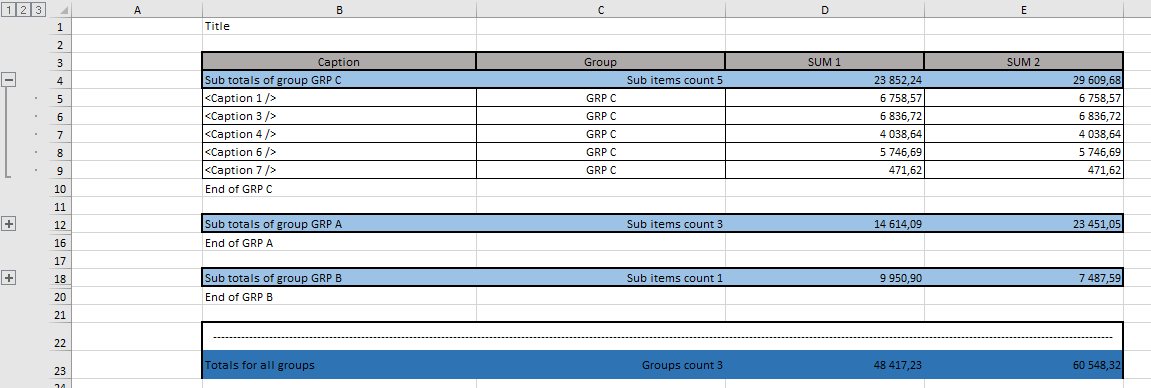xtt->MERGE( IV_BLOCK_NAME = ‘R’ IS_BLOCK =
{"TITLE"=>"Title", "T"=>[{"GROUP"=>"GRP A", "CAPTION"=>"<Caption 1 />", "DATE"=>"2020-10-21", "SUM1"=>5971.44, "SUM2"=>5021.46}, {"GROUP"=>"GRP C", "CAPTION"=>"<Caption 2 />", "DATE"=>"2020-10-19", "SUM1"=>2276.75, "SUM2"=>7717.2}, {"GROUP"=>"GRP B", "CAPTION"=>"<Caption 3 />", "DATE"=>"2020-10-20", "SUM1"=>3031.38, "SUM2"=>445.22}, {"GROUP"=>"GRP A", "CAPTION"=>"<Caption 4 />", "DATE"=>"2020-10-21", "SUM1"=>9476.79, "SUM2"=>3683.27}, {"GROUP"=>"GRP A", "CAPTION"=>"<Caption 5 />", "DATE"=>"2020-10-21", "SUM1"=>4604.0, "SUM2"=>5525.85}, {"GROUP"=>"GRP C", "CAPTION"=>"<Caption 6 />", "DATE"=>"2020-10-19", "SUM1"=>2159.71, "SUM2"=>2260.94}, {"GROUP"=>"GRP B", "CAPTION"=>"<Caption 7 />", "DATE"=>"2020-10-20", "SUM1"=>2490.3, "SUM2"=>6388.81}, {"GROUP"=>"GRP A", "CAPTION"=>"<Caption 8 />", "DATE"=>"2020-10-21", "SUM1"=>5476.81, "SUM2"=>406.18}, {"GROUP"=>"GRP D", "CAPTION"=>"<Caption 9 />", "DATE"=>"2020-10-18", "SUM1"=>689.66, "SUM2"=>518.6}, {"GROUP"=>"GRP C", "CAPTION"=>"<Caption 10 />", "DATE"=>"2020-10-19", "SUM1"=>5451.87, "SUM2"=>4061.85}, {"GROUP"=>"GRP D", "CAPTION"=>"<Caption 11 />", "DATE"=>"2020-10-18", "SUM1"=>4573.55, "SUM2"=>5436.0}, {"GROUP"=>"GRP C", "CAPTION"=>"<Caption 12 />", "DATE"=>"2020-10-19", "SUM1"=>1196.35, "SUM2"=>522.46}, {"GROUP"=>"GRP C", "CAPTION"=>"<Caption 13 />", "DATE"=>"2020-10-19", "SUM1"=>7686.95, "SUM2"=>2727.98}, {"GROUP"=>"GRP D", "CAPTION"=>"<Caption 14 />", "DATE"=>"2020-10-18", "SUM1"=>978.18, "SUM2"=>295.55}, {"GROUP"=>"GRP D", "CAPTION"=>"<Caption 15 />", "DATE"=>"2020-10-18", "SUM1"=>71.12, "SUM2"=>8878.56}]}).
If you have ordinary table with simple totals you should use abap internal tables.
But if you also have to display subtotals and other hierarchical structures it’s better to use trees.
There are 2 methods to create trees. In this page I’ll try to explain the first one TREE_CREATE.
About the TREE_CREATE_RELAT you can read in the follwing page.
TREE_CREATE method
" Document structure
BEGIN OF ts_root,
title TYPE string,
t TYPE REF TO data, " better to use general type than zcl_xtt_replace_block=>ts_tree
END OF ts_root.
ls_root-t = zcl_xtt_replace_block=>tree_create(
it_table = lr_table " from 7.5 REF #(lt_rows)
iv_fields = 'GROUP' ). " Name of the fields delimited by ;
The simplest way to describe the method is to imagine ALV grid with different subtotals.
iv_fields = 'BUKRS' " Subtotals by 1 field
iv_fields = 'BUKRS;WERKS' " Subtotals bt 2 fields
to calculate sums (and averages, for example) you should define handler to process tree and subitems
on_prepare_tree_05 FOR EVENT prepare_tree OF zcl_xtt_replace_block
IMPORTING
ir_tree " Type Ref To ZCL_XTT_REPLACE_BLOCK=>TS_TREE
ir_data " Type Ref To DATA
ir_sub_data, " Type Ref To DATA
first of all in the handler you have to cast data to original data types
FIELD-SYMBOLS:
<ls_data> TYPE ts_tree_05,
<ls_sub_data> TYPE ts_tree_05.
" Cast to specific data
ASSIGN:
ir_data->* TO <ls_data>,
ir_sub_data->* TO <lt_sub_data>.
and in the loop you can calculate whatever you need
" And calc sums
LOOP AT <lt_sub_data> ASSIGNING <ls_sub_data>.
<ls_data>-sum1 = <ls_data>-sum1 + <ls_sub_data>-sum1.
<ls_data>-sum2 = <ls_data>-sum2 + <ls_sub_data>-sum2.
ENDLOOP.
In the template if you have different rows formatting for each level you can specify them by ;level= and ;top= additions. If subitems go after parental item just add ;top=X for the level, otherwise ;top= or just omit it.
 Also if you specify outline level in the template it will be replicated in the final report for the corresponding items.
Also if you specify outline level in the template it will be replicated in the final report for the corresponding items.
The result look like in ALV GRID 